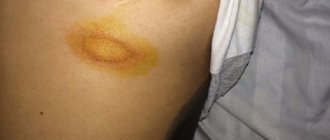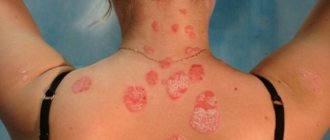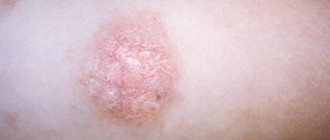What does lichen look like?
As the disease progresses, rashes appear - most often they take the form of small red or brown-purple lumps (on the skin) - a characteristic sign is the shine of the affected areas.
- On the scalp, lichen planus may take the form of small itchy bumps.
- In the mouth - on the surface of the mucous membrane - it can appear as a reticular change in white color.
- On the nail plate, lichen can form cavities and yellowish grooves, and in extreme cases, lead to atrophy of the nail plate.
Lichen planus is an inflammatory disease. It is worth emphasizing that this is not an infectious disease.
Lichen planus
Lichen planus of the oral mucosa
Lichen planus - medicinal
Lichen planus hypertrophic form
Lichen planus - causes
Although the reasons for the appearance of lichen on the skin or mucous membranes remain a mystery, this disease is often associated with autoimmune diseases. The immunological basis of the disease is indicated by the frequent coexistence of lichens with autoimmune diseases, that is, those in which cells of the immune system attack the body for unknown reasons, destroying “healthy” cells.
Lichen planus may appear in people diagnosed with diabetes, vitiligo, alopecia areata, certain liver diseases (including hepatitis and cirrhosis), and ulcerative enteritis (Crohn's disease). Likewise, lichen planus is more common in people who have had a transplant (especially graft-versus-host disease - GVHD) or are taking certain medications, such as penicillamine, methyldopt.
Introduction
Lichen planus (LP) is a chronic inflammatory skin disease that is accompanied by damage to the skin and mucous membranes of the mouth and genitals.
The disease is characterized by papular rashes of various forms and nature and is most often accompanied by severe itching [1]. The prevalence of LP is unknown exactly, but the proportion of patients with this disease at an outpatient dermatologist appointment is 1.3–2.4%. The disease most often occurs in middle-aged people, but cases of the development of LP in children have been described. Women get sick as often as men [2]. Damage to the oral mucosa can develop in isolation or be combined with skin manifestations. Despite the fact that this disease sometimes affects small areas of the skin and mucous membranes, its impact on the quality of life is underestimated [3]. LP is characterized by a chronic course, and spontaneous resolution of the disease is rare [4, 5]. Sometimes different forms of LP may progress with progression of severity and, therefore, require lifelong monitoring and supportive therapy. The treatment of cutaneous forms of LP is most often carried out by dermatovenerologists, and with damage to the mucous membranes - by dentists.
The etiology of LP is still unknown. The pathogenesis of LP is also not entirely clear, but the disease is thought to arise from an immune response presumably involving CD4+ and CD8+ T lymphocytes producing cytokines, interleukin-2 and tumor necrosis factor, which cause a chronic inflammatory response and apoptosis of keratinocytes [6] . Therefore, it is not surprising that this disease is also associated with other diseases that have a common immunological basis [7]. LP is observed in families of different generations, which suggests the presence of a genetic predisposition to this disease [8, 9]. Indeed, genetic polymorphisms of various human leukocyte antigen (HLA) markers, gene polymorphisms of various HLA markers, as well as inflammatory cytokines and chemokines have been studied [10, 11].
The clinical manifestations of LP and their impact on patients are significant. It was shown that CLP significantly affected the quality of sleep, which led to the development of depression in patients [12]. It has also been shown that the longer the duration of subjective symptoms, the worse the quality of life and the higher the level of stress [13, 14]. Thus, the chronic course of LP and, especially, its exacerbation is associated with stress, anxiety, depression and, ultimately, with a deterioration in the patient’s quality of life.
LLP is characterized by a chronic relapsing course. The disease begins with the appearance of widespread rashes, severe itching, and weakness. Often the clinical picture of LP manifests itself acutely. Classic cases of LP are characterized by the presence of dermal-epidermal papules with a diameter of 1–3 mm with polygonal outlines, an umbilical central depression, the absence of peripheral growth, and the presence of a Wickham network caused by unevenly expressed hypergranulosis and visible in the depths of the papules after applying water or glycerin to the surface. Papules are characterized by a bluish-red or lilac color with a pearlescent tint and, when illuminated from the side, a shine. When the size of the elements reaches more than 3–4 mm, they, merging with each other, form larger lesions that take the form of plaques, various figures, and rings. Lichenoid papules are characterized by localization on the flexor surfaces of the forearms, lateral surfaces of the torso, anterior abdominal wall, oral mucosa, and genital mucosa. The front surface of the shin can be considered a favorite place. Lesions in LP can be localized or generalized and have the character of erythroderma. The most torpid course of LP occurs in patients with verrucous, hypertrophic and erosive-ulcerative forms, as well as in combination with diabetes mellitus, arterial hypertension and damage to the mucous membranes (Grinshpan-Wilapol syndrome) [15, 16].
Depending on the skin manifestations, the following forms of LP are distinguished: typical (classical), atypical, hypertrophic, pemphigoid, follicular, pigmented, erythematous, ring-shaped.
The mucous membranes are very often involved in the pathological process; they can be isolated or combined with skin lesions. Isolated lesions of the oral mucosa are observed in the presence of metal dentures. According to the clinical course of LP of the mucous membranes, varieties are distinguished: typical, exudative-hyperemic, bullous, hyperkeratotic [1].
The question of the genetic predisposition of patients to LP remains relevant. Previously obtained results suggest the presence of an associative relationship between LP and HLA complex antigens. The presence in the phenotype of the HLA B35 antigen, as well as combinations of HLA A2-B5, HLA A2-B35, HLA A3-B35, HLA A3-A19 and HLA B12-B35 can be considered as a factor in the development of LP. When studying the distribution of HLA class II specificities, the role of HLA-DRB1*10 predisposing to the development of LP was reliably identified. In turn, the specificities DQB1*11 and DRB1*15 (DR2) play a protective role against this disease [17–21].
Clinical observation of LP
Patient K., born in 1956, was admitted to the skin department of the Kirov Regional Clinical Dermatovenerologic Dispensary on November 18, 2019 with complaints of rashes on the skin of the torso, limbs and oral mucosa. Severe skin itching occasionally bothers me. Notes a decrease in quality of life.
She considers herself sick since the spring of 2022, when rashes first appeared on the back of her feet. The disease is not associated with anything. The patient self-medicated, used an ointment containing betamethasone and antihistamines, but the effect was insignificant. In January 2022, she consulted a dermatologist at her place of residence. She was observed with a diagnosis of “ring-shaped erythema”. She received outpatient treatment with little effect. The disease was chronic. The patient noted that the rash did not go away completely, and the process began to become widespread. She was sent for further examination and treatment to the Kirov Regional Clinical Dermatovenerological Dispensary.
From the life history
. Born and lives in the Kirov region. Secondary specialized education. Does not work. Denies HIV, tuberculosis, hepatitis A, B, C, blood transfusions, previous sexually transmitted infections. Denies drug intolerance. Past illnesses: acute respiratory infections. There is no hereditary history of skin diseases. Denies injuries or surgeries. Denies bad habits.
Chronic diseases: cerebral atherosclerosis, discirculatory encephalopathy stage I, vestibuloataxic and neurosis-like syndromes. Hypertension of the 2nd degree, stage II, risk 3. Dyslipidemia. Varicose veins. Constantly takes medications: atorvastatin, cardiomagnyl.
Gynecological history: menopause since age 45. 8 pregnancies, 2 births.
General inspection.
The condition is satisfactory, consciousness is clear. Physical examination of organs and systems revealed no peculiarities. Heart rate 80 beats per minute. Blood pressure 140/70 mm Hg. Art. Physiological functions are normal.
Local status.
The pathological process is widespread, symmetrical, chronic in the acute stage. It is localized on the skin of the trunk, upper (mainly flexor surfaces) and lower extremities, and on the oral mucosa. It is represented by multiple small dense up to 0.1 cm in diameter, smooth hemispherical, slightly flattened shiny papules of pink-red color with a purple tint. The elements are arranged in a ring shape, with a diameter of more than 5 cm, in the central part of the lesions the skin is of normal color, the peripheral edge consists of adjacent nodules. There are scattered isolated papules with slight peeling on the surface. The Wickham grid sign was positive, and the Koebner phenomenon was also positive. On the mucous membrane of the cheeks and lower lip, small whitish papules are located symmetrically, merging with each other into a thin network. The mucous membranes of the genital organs are free from specific rashes. Dermographism pink. Peripheral lymph nodes are not enlarged (Fig. 1–4).
Clinical blood test
: leukocytes 6.7*109/l (eosinophils 4%, lymphocytes 40.4%), erythrocytes 4.66*1012/l, hemoglobin 137 g/l, platelets 243x109/l, ESR 17 mm/h. General urine analysis: straw-yellow, transparent, protein 0.026 g/l, specific gravity 1.020, glucose - negative, pH 5.5, leukocytes, erythrocytes were not detected. Biochemical blood test: ALT 21 U/l, AST 21 U/l, cholesterol 3.0 mmol/l, total bilirubin 12.1 µmol/l, glucose 5.3 mmol/l, creatinine 89 µmol/l, total protein 74 .3 g/l.
When taking fingerprint smears, Tzanck cells were not found.
HLA phenotype: A02, 09 (24), B12 (44), 35. DRB1* 01, 14.
Biopsy result
. Focal hyperkeratosis, moderately severe acanthosis, in places with a “sawtooth” configuration, focal hypergranulosis of the granular layer, vacuolar degeneration of keratinocytes of the basal and spinous layers, focal spongiosis. In the dermis there is a diffuse band-like lymphohistiocytic infiltrate, in close contact with the basement membrane zone with focal blurring of the dermo-epidermal border. The pathohistological picture is characteristic of LP (Fig. 5, 6).
Treatment was prescribed in accordance with the standard of specialized medical care for LP. The dose of methylprednisolone was prescribed: 4 mg orally according to the scheme (3-2-0) with a gradual reduction in the dose after discharge by 1 tablet once every 5 days until complete withdrawal. As replacement and concomitant therapy, including for the prevention of side effects, the following are prescribed: omeprazole, antihistamines, potassium preparations, calcium gluconate, preparations containing vitamins A and E, ferrous sulfate and vitamin C, hydroxychloroquine (according to 200 mg 2 times a day for 5 days, then a break of 2 days, courses of treatment are recommended to be repeated for 2 months). Local treatment: quenching with fucorcin solution, ointment with fluocinolone acetonide.
Treatment in the hospital lasted 14 days. The patient was discharged in satisfactory condition with improvement under dispensary observation by a dermatovenerologist at her place of residence.
Lichen planus - symptoms
Symptoms of the disease are well expressed:
- red or purple papules;
- skin lesions are usually shiny;
- formations that tend to stick together and appear in groups;
- whitish lines on the surface of the skin (the so-called Wickham grid);
- itchy skin.
Itchy skin
Symptoms of lichen planus usually appear suddenly - skin lesions during lichen planus are usually limited, the rash does not increase after the first symptoms appear.
Types of lichen planus
There are many varieties of lichen planus, including: lichen planus, pigmented, nodular, pemphigoid, linear, follicular, erosive.
The type of lichen can also be determined by the place of its appearance: lichen planus in the mouth, lichen on the nails, lichen of the perianal area, lichen on the genitals: in men, lichen planus is found on the foreskin and on the head, in women, lichen can be found on the genitals lips - and resemble leukoplakia.
Popular questions and answers
Ksenia Bocharova, an allergist-immunologist of the highest category, candidate of medical sciences, member of the World Allergy Organization (WAO), answered our questions about lichen planus
Is lichen planus an allergic disease?
No, lichen planus is not considered an allergy. This is a misconception. In general, it is believed that this is an autoimmune reaction that occurs in our body through excessive activity, so to speak, improper activity of T-lymphocytes. In this case, T-lymphocytes “go a little crazy” and carry out reactions against their own epithelial keratinocytes (skin cells located on the very surface). Moreover, this reaction occurs only in people who are genetically predisposed to this. Sometimes taking certain medications, such as diuretics, can trigger the development of lichen planus. By the way, now (in connection with the coronavirus) antimalarial drugs are being used very actively, they can also. By the way, such damage can also occur due to the use of antibiotics. Here, both the skin and the mucous membrane in the mouth and genitals are damaged. These characteristic inflammatory elements and rashes appear; they have purple papules, are flat and very itchy. They can merge into plaques, and scales may appear on the surface. This disease can occur in different ways, but of course this disease does not apply to allergies.
Which doctor should I go to with this problem, will diet help?
Dermatologists usually treat lichen planus. Considering that this is not an allergic disease, the anti-allergic diet is absolutely ineffective here. She won't help at all. But taking into account the fact that the patient may have other diseases, conditions, he takes pills for these pathologies, and they provoked the appearance of lichen planus, undesirable reactions, then, of course, a diet is needed for the underlying disease. And you need to comply with it. In general, dermatologists diagnose lichen planus based on the characteristic clinical picture and biopsy. In a tissue sample, they look for certain cell changes characteristic of this disease, because similar clinical symptoms can be produced, for example, by lupus erythematosus, candidiasis, and aphthous ulcers (if on the mucous membrane). There may be ankylosing spondylitis on the genitals.
Is it possible to treat lichen planus with folk remedies?
No, it’s impossible, because the doctor usually prescribes serious drugs: glucocorticosteroids or cytostatics. Moreover, this can be a local treatment - apply medicine to an ulcer or wound, or there can be a systemic treatment. Or maybe local injection of a glucocorticosteroid into these elements, which do not resolve for a long time. For treatment, drugs are sometimes used for a long time. And therefore, self-medication is definitely not suitable here. And the diagnosis must be clearly stated, and not at all on the Internet. Yes, Internet resources provide some information, but sometimes even specialists cannot help you correctly determine the diagnosis. With this disease, definitely go to a dermatologist for a dermatoscopy and biopsy, and then only decide on the volume of therapy. Sometimes, in addition to the above methods, phototherapy will be used, but this is not just a solarium, this is therapeutic therapy with strictly adjusted doses and wavelengths.






